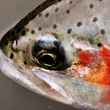The fly-fishing systems we employ should draw on our knowledge and streamside experience. The system described below, which focuses on using ultra-thin mono to build a Euro-nymphing rig, was developed based on those two criteria. Everyone’s knowledge and experiences—as well as the water types we each fish—differ, so take what you read below and apply it to your fisheries accordingly. Hopefully, you’ll find a bit of information that helps you with your journey towards becoming a more effective Euro-nymphing angler.
The Specs
When constructing an ultra-thin Euro-nymphing rig, I utilize 35-40’ of 6lb Maxima Chameleon (connected directly to backing) followed by 2’ of 3X or 4X Scientific Angler sighter material, then a level segment of 4X-6X tippet. When fishing directly under the rod tip, at close range, tippet length is 1-2’ longer than the average water depth. I don’t need a tapered leader or one that has multiple knot connections. Any knotted connection will catch within the guides, even knots that are coated with UV resin. I prefer not to have any knots going through the guides when casting or playing fish, which is why I opt for a level and seamless 35-40’ section of mono for my base leader.
Thinner = Less Mass
Thinner rigs result in less mass within and outside the guides. Ultra-light mono rigs create less pullback on the nymphing rig as it rides within the water column. The reason why I rarely need to use split shot while fishing light to medium weighted tungsten patterns (2.0mm-2.5mm) in moderate current is due to how light my mono rig is. I would need heavier flies or need to add split shot if I used heavier mono, such as 15lb or 20lb, when fishing the same water. By extension, this is why I no longer use Euro fly lines which possess more mass than 20 lb test mono as again, I would need to fish heavier flies anytime I add mass within and outside the guides. If you’re trying to understand how some anglers are able to achieve deep drifts in heavy water with little weight, much of it is a result of their efforts to “thin out” their mono rig.
Easier Casting
Casting is also easier when using thinner mono systems. When Euro-nymphing, traditional fly casting gives way to something that more closely mirrors spin casting—a heavy lure pulls thin line through the air. This negates the need for a heavier, 15-20 lb butt section in my mono rig leader, as the mass or taper of the leader is not used to make the cast. Instead, the weight of the nymph or nymphs is utilized to pull or propel your rig to the intended target. The lighter and thinner the mono rig, the less mass the weight of the nymph must propel to its destination. This is why the use of a thin mono rig makes casting easier. If you use a heavy nymph with an ultra-thin mono rig, you’ll be able to shoot distance with little to no backcast needed.
Enhanced Strike Detection
Strike detection is enhanced when using thinned out mono, simply because thinner mono is more sensitive than thicker mono. There’s little doubt when a trout takes when using a mono rig—the sighter will suddenly jumptowards the fish. In contrast, when using thicker mono, a trout strike can often look the same as when your fly snags bottom, but there’s little doubt when a trout takes while using thin mono. I’ve noticed both myself and my students quickly decoding the difference between bottom and a fish when using an ultra-thin mono rig.

Disadvantages of ultra-thin mono
There’s no such thing as a perfect rig, so it’s important to consider a few of the drawbacks when using ultra-thin mono systems. Despite the drawbacks, I still find the positives outweigh the negatives.
Line Management
Mono is difficult to manage with line hand, especially during colder weather. Despite all the benefits of mono listed above, you won’t be able to take advantage of them if you’re unable to manage mono with your line hand. Due to its diameter and slickness, some anglers find it difficult to grab onto thin mono rigs when stripping or retrieving.
Tippet Mismatch
Ultra-thin mono rigs (e.g. 4-6 lb.) are not ideal when fishing heavier tippets, since your tippet strength may be stronger than the rest of your mono rig. In these circumstances, it is necessary to bulk up the rest of your rig. For example, if I’m fishing 3X tippet on Montana’s Madison River, I’ll opt to use 15lb for my mono base. Tippet diameter should impact the diameter of your mono rig.
Lack of Versatility
While thin mono is deadly effective for Euro-nymphing, it lacks the power to cast dry flies or any type of wind-resistant indicator. When you’re using an ultra-thin rig, Euro-nymphing may be the only tactical option you have since your rig lacks the power needed to cast dry flies or indicators. This is another reason some Euro rigs use thicker mono (15-20lb) as their base, as this diameter often has the thickness and mass to aid in casting.

Reel Management
Mono tends to slip through the cracks with regular fly reels, which is why you may find it useful to use a full frame reel, otherwise known as Euro reels (like this one, or this one, or this one (Euro model)). These reels have a full 360-degree cage which prevents mono from slipping through the cracks. Using any reel without a full cage will quickly result in frustration as the mono will constantly slip between the spool and the frame.
Final Word
It is important to use the right rod to cast these ultralight rigs. Traditional fly rods are designed to cast fly line. When utilizing an ultra-thin mono rig, you want a rod designed to cast ultralight rigs. This is where 2 and 3 weight Euro fly rods help. Certainly, it’s not impossible to cast these rigs with traditional action rods, but you will have to work harder to load these rods. Finally, make sure you know the rules and regulations where you fish. Some regulated waters prohibit mono rigs, so know the rules before you cast.
































Comments
Pa flyguy replied on Permalink
I think at this point it is just reinventing the wheel. Started out spin fishing and was taught to keep the line tight and bounce the bait along the bottom. Now, we simply do the same thing with a fly rod and metal jig, but we call it a fly and wala! something new. Of course you need a 10 ft rod specificaly for this. lol
Steve Kukta replied on Permalink
Great write up Goarge, I missed your class last year at upcountry and gave my spot to a friend. Hope you make it back again. I to have “thinned out” down to 10 and 8 lb long mono leaders on 2 reels now, love it! I actually go to 12 lb for winter for that reason of not having the dexterity to grab the thinner line,, and in extreme cold I go to cortlands .17 coated euro and just fish closer unfortunately.. but it works. Again thanks for all you do for us and the learning that never stops with you. Looking forward to more from your fishing adventures in the future.
Regards,
Steve
Charlie P replied on Permalink
9 times out of 10, I'll stick nymphs under my 13' tenkara rod for this type of fishing!
Steve Kukta replied on Permalink
Cane pole, not fly fishing. Lol. Im Kidding of course.
Robert Lampe replied on Permalink
I just did this for the first time. I used a small jig streamer. I found at the end of the swing I could cast 25 ft with a short hual and water anchor. I started stripping back the streamer like normal fly fishing. It seemed really stealthy. It got my wheels turning on how to improve this. Thinking of $$ limp 4lb fluro as the running line and cheap stiff fluro for the leader. And possibly putting 2 ft of some 12lb lead core trolling line in between as a ultra micro skagit system. I have all the ingrediants I might as well give it shot. No I'm not going to really spey cast this it will be more of a george daniels euro cast with the benefit of extra wieght and ultra thin running line. Any ideas?
Pages